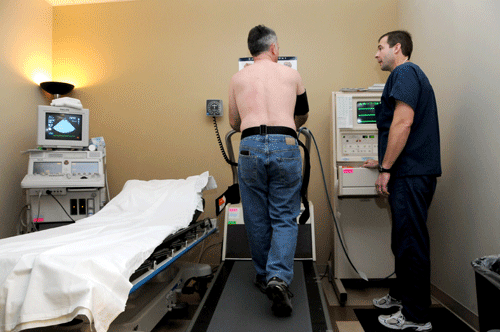Stress Echocardiogram
A Stress Echo has now become one of the preferred techniques for assessing heart function and blood flow through the arteries to the heart under stress, looking for evidence of blockages. It involves a combination of a standard treadmill exercise test and a cardiac ultrasound but has added accuracy as the blood flow through the coronary arteries is further assessed after exercise by looking at the function of the heart, by repeating the ultrasound immediately exercise has finished.
How is a Stress Echo performed? A stress echocardiogram involves taking pictures with the cardiac ultrasound machine, as described in the transthoracic echo section. Following this, further pictures are recorded such that they can be used to compare function of the heart after exercise.
The patient then performs the treadmill exercise test, as described in the exercise test section. Immediately following exercise the patient is placed again onto the bed so further pictures can be obtained of heart function whilst it is still “exercising”.
This process does take a little longer than an exercise test or an echocardiogram, and may take between half an hour to one hour.
How accurate is a Stress Echocardiogram? The ultrasound component of a stress echocardiogram does significantly increase the accuracy of a treadmill exercise test. For significant narrowing’s in major coronary arteries or a narrowing in the main coronary artery, a stress echocardiogram is approximately 95% accurate. For less significant narrowing’s in smaller arteries or branches of the main coronary arteries, this accuracy will drop to approximately 70%. One of the main advantages of a stress echocardiogram over stress testing is a much lower “false positive” rate, (abnormal stress test result suggestive of blocked arteries but on further testing all arteries are normal), particularly in women.

